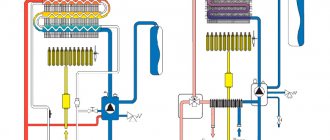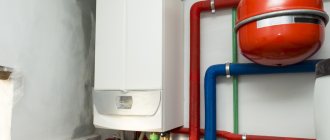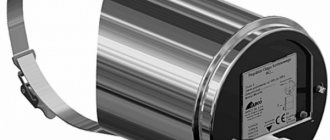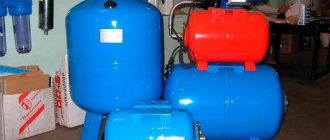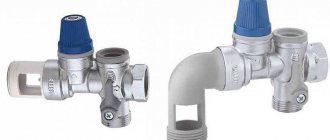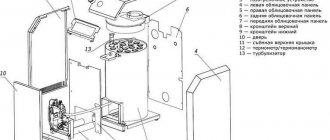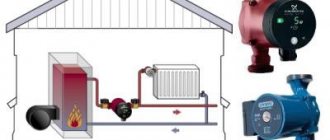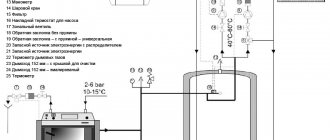A heat exchanger or heat exchanger is a technical device in which the physical principle of transferring heat from a warm medium to a cold one without the use of external energy is transformed into a technological process. It is not an independent device and is used in conjunction with other thermal equipment, therefore it must correspond to it in terms of parameters.
Modern models of heat exchangers are characterized by a high level of safety, productivity, minimal losses of thermal energy in the working process, and reduced costs of coolant and its circulation. These devices are made from the latest materials that are resistant to destructive corrosive effects, which significantly increases their service life. To understand the operation of these devices, let's consider the heat exchange process.
Heat transfer concept
Heat transfer is an irreversible physical process in which heat is transferred from hot bodies or media to cold ones. The functionality of the heat exchanger is based on this physical law. The process occurs naturally, without performing any work on the body or environment. It ends when the temperature differences equalize. Heat exchange is carried out in 3 ways:
- Due to thermal conductivity. In this case, heat transfers from one body to another upon contact. Materials, in particular stainless steels, are characterized by different abilities to conduct heat. Metals except lead and mercury are characterized by higher rates. Heat exchange occurs through the interaction of molecules of one substance with another. The intensity of heat transfer is measured by the thermal conductivity coefficient k, which ranges from k = 600...2000 (W/m2K) for viscous media (for example, sugar syrup) to k = 2000...7000 (W/m2K) for water.
- By radiation. These are electromagnetic waves that a substance emits when heated to specific temperature values. This energy is emitted by any body, including biological organisms. The higher the temperature of a substance, the greater the radiation parameters. This energy is partially captured by other bodies and partially rejected. Dark objects absorb thermal radiation more intensely, while light objects reflect more. Heat transfer by radiation plays an insignificant role and, as a rule, is not taken into account in programs for calculating heat exchangers.
- Convection is a type of heat exchange in which thermal energy exchange processes are carried out in flows of gaseous substances and liquids. In solids, convection does not occur. There are two types of convection: natural and forced. The first occurs during non-uniform heating. A forced process occurs when a gas or liquid is forced to mix. The operation of heat exchangers is based on the forced principle.
Operating principle of the heat exchanger
A modern heat exchanger can operate using three main processes:
- convection;
- thermal radiation;
- thermal conductivity.
Devices are classified according to the method by which heat is supplied to a cold object, namely:
- mixing method;
- heat exchange method.
The main difference lies in their operating principle, structure and appearance. That is why it is important, before purchasing a heat exchanger, to study all the types available for sale. The best way to describe the principle of operation of the product is an example with surface units. They are considered one of the most common designs among users. Sensitive elements are concentrated inside this device , which heat up, transferring heat to a cold object.
If you take a mixing unit, it combines the interaction of air and liquid, resulting in a high level of efficiency. Thus, this device becomes easy to manufacture, with a high speed of obtaining the desired result. Only by mixing two different media can similar results be achieved.
Each heat exchanger also has a set of devices that operate on a special principle. They are divided into two types:
- recuperative;
- regenerative.
The first type involves the use of two different liquids. They interact with each other using a dividing wall. During the exchange of temperatures, the flow in both options remains the same and does not change. In the second type of heat exchangers, the presence of a working element can be traced , which at the same time is both a source of supplied heat and a kind of charger. When in contact with liquids, the element heats up, releasing the necessary heat into the space. In this case, the heat flow may change its direction.
Definition and classification
Heat exchangers are technological devices that transfer heat between two media. The installations differ according to the principle of operation into two types:
- Recuperators. In these devices, the coolants are separated from each other by a wall. These include most modern ones, including heat exchangers for hot water supply.
- Regenerators. In these devices, the media between which heat exchange occurs alternately touch the same surface. According to the regenerative principle, heat accumulates in a solid during contact with a hot medium and is transferred to a cold one.
The heat exchanger works for both heating and cooling. This factor expands the scope of application of the installations. Heat exchange devices are used:
- in public utilities;
- at oil refineries, petroleum, chemical enterprises;
- in the energy industry;
- at food and pharmaceutical plants;
- in the gas industry.
The specific model is selected depending on the conditions of the upcoming operation.
. Devices have been developed that, in addition to heat exchange, perform related functions. Heat exchange installations operating on the recuperative principle are divided into types according to the direction of movement of the medium:
- straight-through;
- parallel movement along one route;
- counterflow (most often found in plate heat exchangers);
- countercurrent, with oncoming parallel movement.
Heat transfer methods and types of devices
It is important to classify heat exchange equipment, the types of which are discussed above, by another key factor - the way the media interact in it. Some devices provide heat transfer by direct contact of the coolant with the heat sink and are called mixing devices, others have separate circuits for the flow of two media and are called surface devices.
The second type of device has become more widespread and liquids are heated in it by contacting the carriers through the metal wall of the circuit. Surface heat exchangers are also usually divided into two groups:
- Recuperative, in which the flow of liquids always occurs in one direction and is characterized by a stable constant.
- Regenerative heat exchange devices are characterized by alternation and instability of contacts between two media.
The most effective interaction occurs in regenerative devices, which are widely used in everyday life. These are all types of plate heat exchangers, shell-and-tube and irrigation devices.
Design and operating principle of a simple heat exchanger
Heat exchangers differ in design, but operate on the same principle
. To understand it, consider the design of the simplest installation. A basic device is a container with a casing that cools and heats. The jacket surrounds the container and creates an annular space into which liquid or steam (coolant) is supplied. If cold water is poured into the annular space, the medium in the main container is cooled. If the jacket is filled with coolant, the substance in the main tank will heat up.
Types of surface heat exchangers
The simplest t/o is a pipe in a pipe. A cold tube containing water passes through a larger pipe filled with a hot agent. In this case, the surface of the inner tube heats up and transfers heat to the water. This is how boilers work. If there are many tubes and they are collected in a bundle, then a shell-and-tube heat exchanger is obtained. Devices with a tube bundle secured at the ends with gratings are common in industry and used for domestic water treatment.
Twisted heat exchangers are coils wound in a housing. The interpipe space is filled with another flow. The equipment is used when the pressure of one of the agents is high.
Two-pipe heat exchangers are used to transfer heat in gas-liquid phases. The devices can operate under pressure with high heat transfer.
Spiral t/o
Spiral heat exchangers represent a barrel in which a flat labyrinth with an internal cavity is located like a spiral ribbon. A hot agent moves in a spiral, washed by cold water. The design is difficult to manufacture. But this is the only type of apparatus for heat exchange of an agent containing suspensions, pulp. Hinged lids on both sides allow for easy cleaning of gaps.
The plate heat exchanger is a special design of heating pipes assembled in the form of a flat element of their finned pipes and multi-pass water movement. The plates resemble accordions. Their disadvantage is that they become clogged with scale due to poor water treatment.
Why do you need a heat exchanger in a heating system? Imagine that the water in the pipes is 900. This will lead to rupture of plastic pipes and burns. Each thermal unit has a heating system that allows maintaining temperature parameters.
Connection diagrams
The heat exchange technical apparatus is connected to the system in three ways:
- Independent configuration.
- The parallel configuration (or 1-stage) involves installing equipment according to the name between two communications. The adjustment is performed by the 1st valve. The meaning of the process is to constantly record the set temperature. This is a simple structure that provides good heat transfer, but consumes large volumes of coolant.
- The two-stage configuration efficiently uses the thermal energy of the return flow. Liquid preparation is carried out in a group of 2 units. Such a heat exchanger is called a monoblock, that is, 2 plate heat exchangers made on one frame. The first stage of heat exchange heats the water with the reverse flow of water from the heating system to approximately +40 degrees. The second stage of heat exchange continues the procedure and brings the water temperature to +60 degrees, which corresponds to the generally accepted standard for hot water temperature. In this case, any type of connection can be installed between the heat exchangers. This method is characterized by low coolant consumption - up to 40% due to the use of the remaining unused heat from the return flow of the heating system, and, accordingly, high efficiency.
A competent choice of connection diagram guarantees economical operation. To do this, you need to correctly link the hydraulic modes of hot water supply and heating.
Engine heat exchanger
Each engine in a modern car is equipped with turbochargers that do not operate outside a certain temperature range.
This applies to all systems in the car that contribute to the operation of the engine. When temperatures drop significantly, diesel fuel becomes thick, which significantly complicates not only starting the engine itself, but the operation of the engine as a whole. There are situations that are just the opposite - too active engine activity in the absence of cooling or heat removal. In such situations, significant overheating of the engine is possible, which also negatively affects the unit. Naturally, the risk of adverse consequences increases tenfold with systematic and prolonged overheating. Most of these cases end in a complete repair, starting from the stage of replacing liners and pistons and ending with the replacement of other parts. Modern passenger cars most often use so-called liquid cooling systems. These are closed cooling systems that have low noise levels but provide uniform cooling. In general, the following parts of the cooling system are responsible for maintaining optimal engine temperature:
- radiator with liquid that directly cools;
- oil radiator;
- heat exchanger;
- water pump (operates on the principle of taking heat from parts);
- thermostat (regulates the direction of movement of the liquid that produces cooling), etc.
The engine heat exchanger performs exactly the opposite function relative to the radiator. If a radiator is needed to carry out the process of an already heated liquid, then the heat exchanger helps heat the air that passes through it. This process is necessary to prevent the process that causes the engine oil to foam (air bubbles form when the oil heats up). This is the main problem when heating engine oil, as it ultimately leads to engine failure.
To avoid this kind of unpleasant situation leading to breakdown, the oil also needs constant cooling. If we carefully analyze the entire process of changing the oil temperature throughout the entire cycle, we will note that after being taken, the oil enters the heat exchanger specifically for cooling and only then is sent again in order to lubricate and cool the diesel engine.
Technical characteristics and advantages of heat exchangers
Any heat exchange cooling or heating device is designed on the principle of heat exchange between media, but the designs are different. Devices are created in a wide range. To make the right choice, you need to know:
- types of devices;
- their designs;
- technical and operational parameters;
- appointment.
In various spheres of human activity, regenerative type devices are most in demand; they are classified into the following types:
- minichannel;
- mixing;
- submersible;
- soldered;
- superficial;
- irrigation;
- lamellar;
- ribbed;
- shell-and-tube and others.
Plate devices are highly popular compared to other designs. They are productive, safe, reliable and relatively cheap to manufacture and operate. These are flow-through installations. They are plates assembled into a package of plates, between which heating and heating channels are formed. The plate pack is installed in a frame with a working pressure of 10, 16 or 25 bar.
The flows are separated by walls, so mixing of media is excluded. The conditions under which the device will be operated depend on the quality of the cushioning material, the number of plates in the package, size and shape. Basic operational parameters of heat exchangers:
- installation dimensions;
- temperature range;
- type of execution;
- materials from which the basic elements are made;
- nominal pressure;
- coolant costs.
The correct choice is the first criterion for reliable operation of systems. Like any equipment, they need maintenance, replacement of consumables, and routine repairs. A special feature of maintaining heat exchange equipment is washing the inner walls of the plates. Since hot media circulate inside the structure, at temperatures above +40 degrees foreign substances are formed: scale, rust, and the formation of chemical compounds is also possible. They are deposited on the walls and interfere with heat transfer, that is, they reduce heat transfer coefficients.
To maintain the functionality of the equipment throughout its entire service life, regular flushing of the heating, cooling and hot water supply systems is necessary. Several cleaning technologies have been developed and are used, but the best results are shown by the chemical method (in-place or dismountable methods). Flushing is carried out either according to the schedule of regulations, or when signs of blockage appear.
Operating principle using the example of a plate heat exchanger
This heat exchanger was not chosen easily. It has a rather complex operating principle , and therefore ideally highlights some of the general features of each type of unit.
Each of the device plates is mounted to another part with a rotation of 180 degrees. In the standard composition of the device you can find up to four similar elements. Together they create packages that are responsible for the collector circuit. The circuit itself functions to create coolant movement. The design of the heat exchanger implies the presence of two extreme circuits. They are the ones who do not participate in the process of creating heat by the mechanism. Today, equipment manufacturers offer the user two different types of configuration.
- One-way. The coolant is divided and creates parallel flows. Almost immediately they flow into the outlet port.
- Multi-pass. This option involves the use of a complex circuit. The heat exchanger begins its movement along the same number of channels involved. This principle of operation implies the presence of additional elements (plates), which end with plugs in the outlet ports. This feature adds complexity to the maintenance of such elements.
conclusions
The heat exchanger is a reliable, productive and safe installation. Until recently, imported equipment was considered safer and more durable, but now Russian-made plate heat exchangers are in no way inferior to foreign-made analogues, but are sold at reasonable prices.
Our company sells heat exchange units of any type and production. Deliveries are made to any region of Russia. The products are certified, comply with the technical standards of the Russian Federation and are accompanied by guarantees. Using engineering calculations, our managers will help you choose the right model for specific operating conditions.
Types of heat exchangers
A heat exchanger is a device in which heat is exchanged between two coolants having different temperatures.
Heat exchangers are very common. In the broad sense of the word, heat exchangers include all devices in which heat is exchanged between the heating and heated media.
There are three types of heat exchangers: recuperative (surface), regenerative and mixing.
The design of the heat exchanger depends on the conditions for its use. There are heat exchangers in which related processes, such as phase transformations, for example, condensation, evaporation, and mixing, occur simultaneously with heat exchange. Such devices have their own names: condensers, evaporators, cooling towers, mixing condensers.
Design and principle of operation of KAMAZ oil heat exchangers
Currently, only shell-and-tube (tubular) type LMCs of various modifications are used on KAMAZ engines. Structurally, this unit is quite simple, it consists of the following parts:
- Housing (casing);
- Core with deflector;
- Supply manifold;
- Outlet manifold.
The basis of the design is an aluminum cylindrical body (casing), on the wall of which there are channels and mating surfaces for connection to the oil filter block (installation is carried out through gaskets). The ends of the casing are closed with special covers with pipes - inlet and outlet manifolds, the first ensures the supply of coolant from the water jacket of the cylinder block into the housing, and the second takes the liquid back to the engine cooling system. The housing has drillings and channels for the installation of bypass valves, which ensure oil bypass bypassing the heat exchanger if its core is clogged.
A core is installed inside the body - an assembly of thin-walled copper or brass tubes placed in a package of transverse metal plates. On the core there are five plates with a protruding part, which divide the entire part into four sections, which ensures a change in the direction of oil flow. On one side of the core there is a flange, which during installation rests against the end of the housing; on the opposite side, the flange has such a diameter as to fit tightly inside the casing, and there are several o-rings on it. This design ensures separation of the coolant and oil flow, preventing them from mixing. And to ensure the correct direction of oil flow, a deflector is located on one side of the core - an open metal ring with a slot.
Heat exchangers for baths: characteristics
A heat exchanger for a bath can be classified depending on its location in relation to the heating device. Thus, the device can be located directly in the body of the stove, near the chimney pipe or near the body of the heating device. Similar units are designed to perform the same functions. By contacting the hot surface of a chimney or firebox, they heat liquid in a container of impressive size, using the principle of convection. Their use allows the owners to place the water tank not in the steam room itself, but in the adjacent room. You can make such a device yourself, using steel sheets and pipes. You just won’t be able to carry out the work if you don’t have a welding machine and don’t have the skills to work with it.



